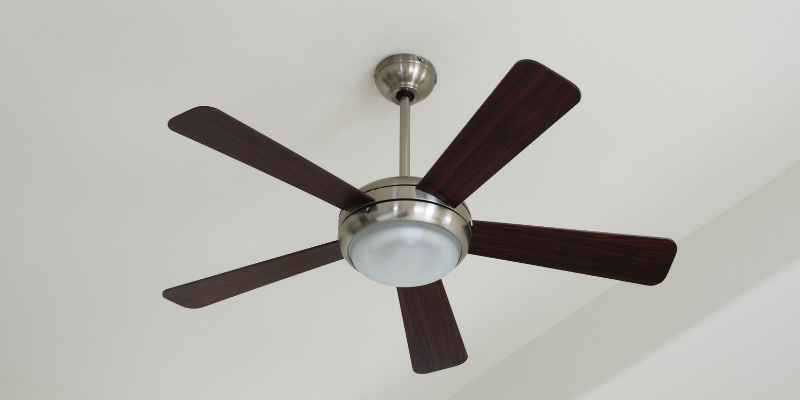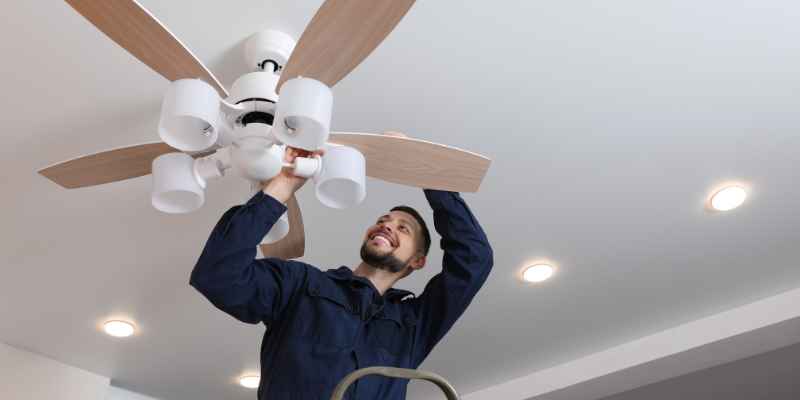The direction of fan blades is important for optimal airflow and energy savings. Ceiling fans should spin counterclockwise in the summer for a cool breeze and clockwise in the winter to circulate warm air.
Proper fan direction can lower energy bills and make a room feel more comfortable in any season. Learn more about the direction of fan blades from reputable sources such as Hunter Fan, Home Depot, and Lowe’s. Ceiling fans are a popular and practical addition to homes, providing comfort and style while also saving energy.
However, many people may not realize that the direction of a ceiling fan’s blades plays an important role in its effectiveness. By simply flipping a switch, the airflow can be adjusted for optimal comfort and energy efficiency. We will explore the direction of fan blades and how it affects the temperature in a room. We will also provide tips for setting the correct direction in the summer and winter, and share insights from industry experts.
Understanding Ceiling Fans
Ceiling fans are both practical and aesthetically pleasing, but did you know the direction of your fan blades plays an important role in its effectiveness? Depending on the season, it’s important to change the direction of your ceiling fan’s blades to either push warm air down or cool air up for maximum comfort and energy savings.
Check out guides from Hunter Fan, Home Depot, and others for tips on how to optimize your ceiling fan’s direction.
How Does A Ceiling Fan Work?
Ceiling fans work by rotating blades that move air around the room. The blades are attached to a motor that spins them around. As the blades turn, they create a breeze that moves air around the room. This can help to cool the room in the summer and warm it in the winter. A ceiling fan can also help to circulate air, making a room feel less stuffy.
Key Components Of A Ceiling Fan
There are several components that make up a ceiling fan. The most important is the motor, which powers the fan and spins the blades. The blades themselves are also critical components, as they are responsible for moving the air around the room. Other important components include the blade irons that hold the blades in place, the down-rod that connects the fan to the ceiling, and the mounting bracket that secures the fan to the ceiling.
Ceiling fans are a great addition to any home, providing both comfort and style. By understanding how ceiling fans work and the key components that make them up, you can choose the best fan for your home and ensure that it operates effectively. One important consideration is the direction of the fan blades. During the summer, the blades should spin counterclockwise to create a breeze that cools the room. In the winter, the blades should spin clockwise to create an upward draft that pulls warm air down from the ceiling. By adjusting the direction of the fan blades based on the season, you can maximize the benefits of your ceiling fan.

Seasonal Ceiling Fan Direction
The direction of fan blades can have a significant impact on the airflow and energy savings of a ceiling fan. By changing the direction in which the blades spin, you can maintain a comfortable temperature in your home during both summer and winter months.
Learn more about the correct fan direction for each season to save money and keep your home comfortable.
Ceiling fans are a great addition to any room in your home, but did you know that their direction can have a significant impact on your energy bills and overall room comfort? By changing the direction of your ceiling fan blades based on the season, you can improve airflow and reduce energy usage. Let’s take a look at the optimal direction for your fan blades during the summer and winter months.
Summer Ceiling Fan Direction
During the summer months, it’s best to have your ceiling fan blades rotate counterclockwise. This way, they will push the air straight down and create a cooling breeze that will make your room feel more comfortable. This direction also helps to evaporate any moisture on your skin, making you feel cooler than the actual room temperature.
Winter Ceiling Fan Direction
When the colder months roll around, you’ll want to reverse the direction of your ceiling fan blades to rotate clockwise. This will create an updraft that pushes warm air down from the ceiling and circulates it throughout the room. By doing this, you’ll be able to use less heating and save money on your energy bills.
In Conclusion
Making a simple switch to the direction of your ceiling fan blades can make a big difference in your energy usage and overall room comfort. By following these guidelines, you’ll be able to keep your home feeling comfortable all year round. Remember, counterclockwise for summer and clockwise for winter!
Benefits Of Correct Ceiling Fan Direction
Changing the direction of fan blades in summer and winter can have significant benefits in terms of saving energy and staying comfortable. Rotating the ceiling fan blades in a counterclockwise direction during summer months creates a cool breeze, while reversing the fan and running it clockwise in winter traps warm air inside the room to keep it cozy.
Ceiling fans are a great addition to any room to help keep the air moving and maintain a comfortable temperature. However, did you know that the direction of your ceiling fan blades plays an important role in maximizing its effectiveness? Switching the direction of your fan blades according to the season can save you money on your energy bills and help maintain the longevity of your fan. In this blog post, we will discuss the benefits of correct ceiling fan direction, including energy efficiency and comfort.
Energy Efficiency
When it comes to saving money on your energy bills, every little bit counts. By changing the direction of your ceiling fan blades to rotate counterclockwise in the summer, you can create a wind chill effect that will make the room feel cooler. This will allow you to raise the temperature on your thermostat without sacrificing comfort. Similarly, in the winter, changing the direction of your fan blades to rotate clockwise will push warm air down from the ceiling, making the room feel warmer and allowing you to lower the temperature on your thermostat.
Comfort
Maintaining a comfortable temperature in your home is essential for your well-being. In the summer, the wind chill effect created by your ceiling fan will help to make the room feel cooler, reducing the need for air conditioning and keeping you comfortable. In the winter, the warm air pushed down by your fan will help to evenly distribute heat throughout the room, keeping you warm and cozy. Additionally, using a ceiling fan can help to reduce stuffiness and remove stale air from the room, creating a fresher and more comfortable environment.
In conclusion, switching the direction of your ceiling fan blades according to the season can provide numerous benefits, including energy efficiency and comfort. Remember to rotate your fan blades clockwise in the winter and counterclockwise in the summer to get the most out of your ceiling fan.
Identifying The Correct Ceiling Fan Direction
Knowing the direction of your ceiling fan blades is essential to keep you comfortable and save energy. In the summer, the fan should turn counterclockwise to push air down and create a cooling breeze, while in the winter, it should rotate clockwise to circulate warm air trapped near the ceiling down to the floor.
Invest in a ceiling fan that allows you to switch the direction of the blades easily.
Clockwise Vs Counterclockwise Rotation
If you’re trying to identify the correct ceiling fan direction for your home, then you should know that it all comes down to the clockwise and counterclockwise rotation of the fan blades. During summer, you want the blades to rotate counterclockwise, while during the winter, they should rotate clockwise.
But why is that? The counterclockwise rotation during summer creates a wind-chill effect that makes the room feel cooler, while the clockwise rotation during winter helps to distribute warm air that rises to the ceiling back down to the floor, keeping the room warm and cozy.
Using An On/off Switch
Most ceiling fans come with a switch located on the motor housing that allows you to change the direction of the fan blades easily. To identify the correct direction, turn the fan on and stand directly under it. If you feel the cool breeze blowing down on you, then it’s rotating counterclockwise, which is ideal for summer. If you don’t feel any airflow, then turn off the fan and flip the switch to change the direction to clockwise for winter.
Identifying the correct ceiling fan direction can help you save energy and money on your heating and cooling bills. So make sure to check the direction of your fan blades regularly and adjust it accordingly.
Common Ceiling Fan Direction Mistakes
Did you know that the direction of your ceiling fan blades plays an important role in its function during summer and winter months? Setting your ceiling fan to the correct direction can improve airflow, save energy, and keep you comfortable throughout the year.
Make sure to check the direction of your fan blades for optimal performance.
Not Adjusting The Fan Direction
If you’re like most people, you probably installed your ceiling fan, set it to one direction, and never looked back. However, not adjusting your ceiling fan direction as necessary can impact its efficiency and keep your rooms feeling uncomfortable. It’s important to realize that you may need to adjust your fan’s direction depending on season, weather, and room use. Failure to do so could create the potential for increased energy use, less air circulation, and decreased comfort levels.
Incorrect Direction For The Season
Another common mistake people make is setting their ceiling fan’s direction incorrectly in summer or winter. During the summer, you want your fan to create a breeze and circulate cool air around your room. Therefore, your fan blades should spin counterclockwise (when viewed from below). Conversely, during the winter, you want your fan to push warm air from the ceiling down to your living spaces, which helps to reduce heating costs. Therefore, your fan blades should rotate clockwise (when viewed from below) in the winter.
Inefficient Fan Speed
Finally, the speed of your ceiling fan can also contribute to inefficiency and decrease comfort levels. As a general rule, you’ll want to set your fan to a low speed during winter and a medium or high speed during summer. Remember, your fan’s speed setting should complement the direction it’s rotating for the most efficient airflow and temperature control.
By avoiding these common mistakes, you can ensure that your ceiling fan operates effectively year-round, keeps your rooms comfortable, and helps to save energy and reduce costs.
Troubleshooting Ceiling Fan Direction
Make sure you are getting the most out of your ceiling fan by ensuring the blades are rotating in the correct direction. In the summer, the blades should be rotating counterclockwise to create a cool breeze, while in the winter, they should be rotating clockwise to circulate warm air.
Don’t forget to switch the direction for each season!
Solutions For Incorrect Direction
If your ceiling fan is rotating in the wrong direction, don’t worry. There are generally two ways to troubleshoot ceiling fan direction –
- Manual method (No need for a professional)
- Remote method (Need for professional service)
Manual Method: When To Call A Professional
If you’ve tried the manual method and haven’t had any success, it may be time to call in a professional. A professional would check if there is any electrical or wiring issue causing the problem. They will also ensure that the fan is correctly installed and balanced. Attempting a repair without properly trained technicians can be dangerous and may result in further expensive repair.
Remote Method
If you’ve lost or misplaced your ceiling fan remote, then you can order a replacement from the manufacturer or buy a universal remote from a hardware store. But if it’s not the remote and your fan isn’t spinning in the correct direction, you may have a faulty capacitor or motor. In that case, it’s best to call in a professional to diagnose and repair the problem.
Other Reasons Your Ceiling Fan May Not Be Working Well:
- Faulty Capacitor: The capacitor regulates the speed of the fan’s motor. If it’s not working properly, then your fan won’t work or will work poorly.
- Wiring Issues: Ceiling fan motors require a specific type of wiring, and if it’s not correctly installed, it can prevent the fan from working at all or spinning in the incorrect direction.
- Imbalanced Blades: Sometimes, the angle of the blades of your fan can affect the rotation and direction if your fan blades are not correctly balanced, that could be another reason why the fan is not spinning in the correct direction or is behaving strangely.
Remember, troubleshooting ceiling fan direction issues can be complicated so don’t hesitate to call for assistance. Always choose a licensed electrician or professional to help you with electrical problems.

Frequently Asked Questions For Direction Of Fan Blades
What Is The Ideal Direction For Fan Blades In Summer?
During summer, your fan should spin counterclockwise. This direction creates a downdraft that pushes cool air towards the floor, creating a wind-chill effect. It makes you feel cool and comfortable.
How Does The Direction Of Fan Blades Affect Energy Consumption?
Ceiling fan blades affect energy consumption based on the direction they rotate. The counterclockwise direction creates a downdraft that pushes cool air towards the floor, creating a wind-chill effect, which reduces the need for air conditioning. This can save up to 30% on energy bills.
Can Ceiling Fans Help In Winter As Well?
Yes, ceiling fans can help in winter too. You should spin the fan blades clockwise in winter at a low speed to circulate warm air throughout the room. It will help in maintaining the temperature and reduce the load on your heating system.
What Is The Role Of The Direction Of Ceiling Fan Blades?
The direction of ceiling fan blades determines the airflow in your room. It creates a wind-chill effect that makes you feel cool in summer and circulates warm air throughout the room in winter. Proper direction can reduce energy consumption and save money on bills.
Conclusion
Proper direction of fan blades is crucial for optimal airflow and energy savings. During the summer, ceiling fans should rotate counterclockwise to create a cool breeze, while in the winter, they should rotate clockwise to gently circulate warm air. By making a simple switch, ceiling fans can keep you comfortable and help to save money on energy bills.
Remember to reverse the direction of fan blades each season to achieve maximum benefit. So, make sure to check your fan’s direction and start enjoying the benefits today!


